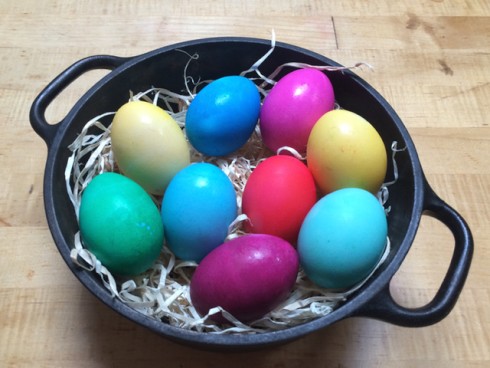Vinegar is acidic and contains around 3 acetic acid. Lemon juice did pretty well but yielded more color marbling.

Add 1 tablespoon of white vinegar to each bowl and 1 to 2 drops of food coloring.
Dying eggs with vinegar. Make sure that they are each large enough to accommodate an egg but small enough that two-thirds cup liquid will cover the egg. Step 2 Add 2 tbsp. Distilled white vinegar to each cup or bowl.
In actuality vinegar is the secret ingredient. The acetic environment created by vinegar allows the coloring agent to actually bond to the eggs calcium shell. The ideal pH balance for perfectly-dyed eggs is around 3-4 and adding vinegar to the dyeing solution does the trick.
You can make a brighter egg dye solution by dissolving the egg dye tablets into distilled white vinegar instead. Pour one cup of vinegar into a container with one egg dye tablet. Moreover is there a substitute for vinegar when dying Easter eggs.
Replace the vinegar with an equal amount of lemon or lime juice. Similarly what does the vinegar do when dying eggs. Vinegar is acidic and contains around 3 acetic acid.
When you add vinegar to water it creates ideal conditions for food coloring to dye the egg. Since eggs are made out of calcium carbonate this calcium in the shell reacts with the acid in the vinegar to make carbon dioxide. Dying Eggs with Vinegar - YouTube.
Dying Eggs with Vinegar. If playback doesnt begin shortly try restarting your device. Heres how the experiments turned out.
The deepest most even color was from vinegar in the dye followed closely by the eggs boiled in vinegar water. Lemon juice did pretty well but yielded more color marbling. The dye using plain water no acid gave me a much paler and less evenly colored egg.
Vinegar is acidic and contains around 3 acetic acid. When you add vinegar to water it creates ideal conditions for food coloring to dye the egg. Since eggs are made out of calcium carbonate this calcium in the shell reacts with the acid in the vinegar to make carbon dioxide.
Can you use apple cider vinegar instead of white vinegar to dye eggs. Making homemade egg dye with food coloring is super easy. Start by prepping a few heatproof mugs or bowls.
Youll want one for each color egg you plan to mix. In each cup pour in a half cup of boiling water a teaspoon of vinegar and the food coloring of your choice. Adding a vinegar substitute will help to ensure that more of the dye sticks to your eggshells.
Use 1 teaspoon 49 mL of lemon or lime juice in place of 1 teaspoon 49 mL of vinegar or use 1 teaspoon 49 mL of vitamin C powder instead of 1 teaspoon 49 mL of vinegar. Boiling the eggs in the dye will also help to make the color stick. Add 1 tablespoon of white vinegar to each bowl and 1 to 2 drops of food coloring.
Or more if you would like them darker If you would like them darker add around 3 to 5 drops. Use a spoon to stir each color. I recommend adding colors slowly a little bit goes a.
Step-by-Step Directions Step 1. Hard-Boil Eggs Before you can dye Easter eggs youll have to cook them. Learn how to hard-boil eggs in a pan on.
Prepare Bowls of Dye While your eggs are cooling mix up your dye. Add 1 teaspoon of white vinegar and 20 drops. If you plan to draw on the eggs with crayons assemble the crayon colors you want.
The dye will not adhere to the wax allowing the crayon color to show through. You can also use rubber bands to create a striped effect Place one teaspoon of vinegar in each container. Add about 1 12 cups of hot water hot tap water is fine to the vinegar.
STEP 1. Place ½ Tablespoon of baking soda into each cup. Add 5-6 drops of food coloring to each cup and mix with a spoon.
Place one hard boiled egg into each cup. Place cups on a sheet pan or 913 pan. Pour 13 cup of vinegar into each cup and watch it bubble up.
There might be some. The purpose of adding vinegar to the water and dye is to help the dye bond to the eggshell. Without it you can still dye eggs but the color wont be as vibrant.
Instead of vinegar you can substitute lemon or lime juice in the same proportions as listed above. So if you do egg-dying as a science with your kiddos sometime try. Lemon juice dyeing for longer than 2 minutes per egg natural dyes made yourself or store-bought and maybe fresh eggs versus eggs that have been in the fridge a bit longer.
Looking around the internet I discovered some people use salt to dye their eggs instead of vinegar. Vinegar-only was good at dying the eggs a vibrant color but it presented a different problem. There was so much bubbling on the surface of the egg when we dropped it.
I have some egg dyes which come with three recipes. In one you dissolve them with just water to get pastel shades in another you dissolve them with lemon juice and water to get slighly darker shades and in the third you dissolve them with vinegar and water to get the darkest shades including red yay. - it used to be impossible to find red egg dye in the US.